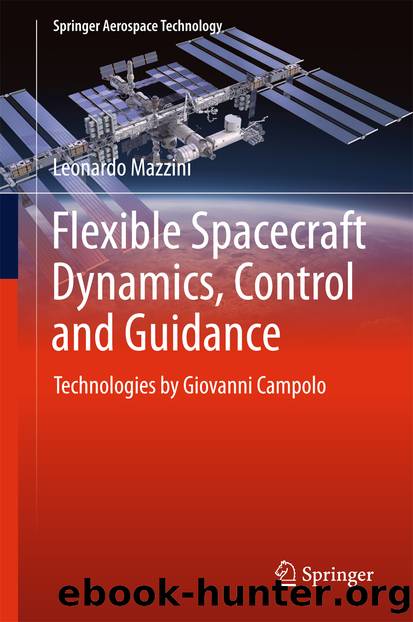Flexible Spacecraft Dynamics, Control and Guidance by Leonardo Mazzini

Author:Leonardo Mazzini
Language: eng
Format: epub
Publisher: Springer International Publishing, Cham
(5.64)
It follows that , and also that
(5.65)
So, as we wanted to demonstrate: , being the minimal distance of all the eigenvalues of from the critical point .
It is well known that where the are considered with their multiplicity.
If the system is stable, and we multiply the open loop transfer L by a factor k, we have .
So, as we wanted to demonstrate: it follows that and the closed loop system remains stable after the application of the multiplicative factor k.
The gain margin of the MIMO is the minimum real amplification factor which brings an eigenvalue to cross the critical point . The phase margin of the MIMO is the minimum rotation such that brings an eigenvalue to pass across the critical point . When an eigenvalue of L crosses the critical point the complete system becomes unstable.
The complementary sensitivity T is such that as can be easily verified from the definition given by Eq. 5.60. This means that when we have a low sensitivity the complementary matrix must be close to the unit matrix.
From Eq. 5.61 . We can use this property to guarantee the stability versus multiplicative perturbations of the primitive plant. Reusing the scheme of Fig. 5.2 on the G(s) of Fig. 5.4 any multiplicative perturbation of the plant G such that ensures that:
Download
This site does not store any files on its server. We only index and link to content provided by other sites. Please contact the content providers to delete copyright contents if any and email us, we'll remove relevant links or contents immediately.
| Automotive | Engineering |
| Transportation |
Whiskies Galore by Ian Buxton(41530)
Introduction to Aircraft Design (Cambridge Aerospace Series) by John P. Fielding(32888)
Small Unmanned Fixed-wing Aircraft Design by Andrew J. Keane Andras Sobester James P. Scanlan & András Sóbester & James P. Scanlan(32573)
Craft Beer for the Homebrewer by Michael Agnew(17933)
Turbulence by E. J. Noyes(7700)
The Complete Stick Figure Physics Tutorials by Allen Sarah(7141)
Kaplan MCAT General Chemistry Review by Kaplan(6595)
The Thirst by Nesbo Jo(6437)
Bad Blood by John Carreyrou(6275)
Modelling of Convective Heat and Mass Transfer in Rotating Flows by Igor V. Shevchuk(6223)
Learning SQL by Alan Beaulieu(6035)
Weapons of Math Destruction by Cathy O'Neil(5829)
Man-made Catastrophes and Risk Information Concealment by Dmitry Chernov & Didier Sornette(5647)
Digital Minimalism by Cal Newport;(5389)
Life 3.0: Being Human in the Age of Artificial Intelligence by Tegmark Max(5184)
iGen by Jean M. Twenge(5161)
Secrets of Antigravity Propulsion: Tesla, UFOs, and Classified Aerospace Technology by Ph.D. Paul A. Laviolette(4992)
Design of Trajectory Optimization Approach for Space Maneuver Vehicle Skip Entry Problems by Runqi Chai & Al Savvaris & Antonios Tsourdos & Senchun Chai(4840)
Electronic Devices & Circuits by Jacob Millman & Christos C. Halkias(4748)
